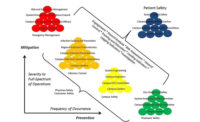The IRSST just published a new research report those purpose is to contribute to confined space accident prevention by helping companies apply existing regulations. Researchers wanted to gain a better understanding of confined space risk management and identify issues based on the literature and field observations, and develop a confined space risk analysis and work categorization tool that meets the needs defined in the first stage of the project.
A confined space is any area that is completely or partially enclosed and is not designed for human occupation, nor intended to be, but may occasionally be occupied for the performance of work. (Definition from Quebec Regulation respecting Occupational Health and Safety (ROHS), section 1) A worker may therefore enter such a space that is not a workstation, has restricted access, and presents a risk to health and safety.
The issue of confined space work cuts across a wide range of sectors: municipal, manufacturing, chemical, military, agricultural, construction and transportation. The most common confined spaces in industry are tanks, reservoirs, silos, vats, manholes, pits, sewers, pipes and tank cars or trucks that have certain characteristics defined in the regulations. Workers enter confined spaces to perform maintenance, manufacturing or other tasks (e.g., construction industry).
The occupational health and safety hazards are primarily atmospheric, biological, physical and ergonomic. The risks run by workers who enter these confined spaces are potentially high because of the confinement, inadequate natural ventilation, need to work in isolation, and access, rescue and communication problems. Moreover, accidents are common in confined spaces.
The findings show that, first, the number of fatal accidents caused by an equipment energy control problem highlights the importance of mechanical hazards in confined spaces. A more multidisciplinary approach would therefore seem desirable. Second, the risk estimation and assessment stages are seldom dealt with formally in the literature, with the exception of atmospheric risks.
A five-step risk assessment tool was developed for confined spaces.
- Step 1 of the tool consists of a list of 26 closed-ended questions intended to characterize the confined space, its environment and working conditions.
- Step 2 describes the accident process related to the risks identified by the tool user.
- Step 3 facilitates risk estimation using a risk matrix and criteria tailored to the context of confined spaces. For this purpose, risk estimation tool design criteria recently proposed for machine safety were applied.
- Step 4 provides a graphic classification by risk categories and levels.
- Step 5 consists of a feedback loop that estimates residual risks once the risk reduction measures have been selected.
The tool can be used to determine, on the basis of explicit criteria, whether any two confined space job assignments are actually identical, with a view to simplifying risk reduction work if possible. The tool can also help decide, on the basis of predetermined criteria, whether rescue without entry is possible a priori and whether the residual risks are acceptable. Twenty-two confined space experts were asked to test the tool’s practicality and suitability. The tool was also compared with other types of tools recommended in the literature or by businesses for analysing risks associated with confined space work.
This study provides support for designers, safety officers and rescuers in their respective efforts to improve the health and safe working conditions of people who must enter confined spaces. The tool can be used to design a confined space or to assess an existing one.
To download the report: http://www.irsst.qc.ca/en/publications-tools/publication/i/100915/n/confined-space-analysis-tool




